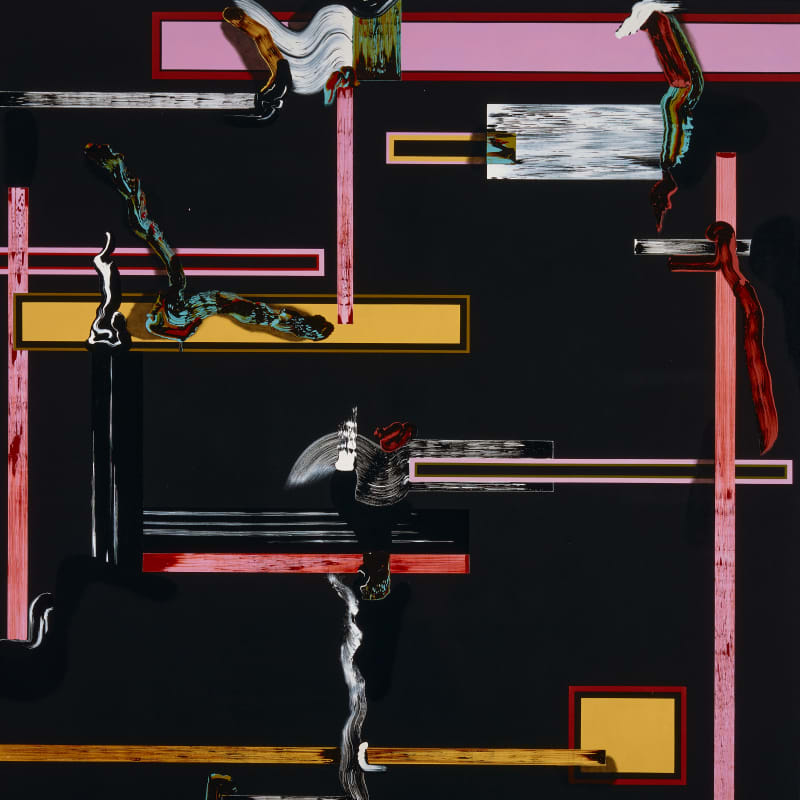Galerie Nathalie Obadia is pleased to present Ensemble, Fiona Rae's ninth solo exhibition at the gallery since 1994. Internationally recognized as one of the pioneers of contemporary abstract painting, Fiona Rae presents thirteen emblematic works made across the last three decades, retracing the major steps in the evolution of her practice from 1997 to the present day.
Having studied at both Croydon College of Art and then Goldsmiths, graduating in 1987, Fiona Rae was quickly identified as an emerging figure in the British art scene, among the other Young British Artists (YBAs). Alongside Damien Hirst, Sarah Lucas, Gary Hume, Michael Landy and Angela Bulloch - all of whom Rae met during her studies - she participated in the iconic exhibition Freeze in 1988, organised in an abandoned building in the London Docks. This event is considered as the inaugural manifestation of a generation that deeply marked the United Kingdom's artistic landscape in the 1990s.
While Fiona Rae might share the iconoclastic attitude of the Young British Artists, her oeuvre differentiates itself through her personal reinterpretation of abstract painting. At a time when the medium had been deemed obsolete, she reactivated its vitality, her compositions incorporating a large range of references: art history, Japanese and European animation, graphic design, theatre, music, and literature. This openness gives her work its singular character, both rooted in the tradition of fine art while also in conversation with the cultural evolutions of its time.
Tomb Raider (1997), the first piece in this selection of works, marks an important step in Rae's formal explorations. The circles, which she describes as "cosmic viruses," maintain an ambiguous relationship with the swarming background of vivid paint. These dynamics become parts of a visual system where each element is dependent on the other to produce meaning. "This gives a sense of unease," the artist comments, "it's as if the very fabric of the painting could also be its undoing."¹ The work thus affirms an open pictorial approach, refusing any form of fixation in order to better "signify the unpredictability of life,"² as Simon Wallis states. Preacher 2 (1998) is an expansion of this reflection whilst also marking a rupture: the lively background relinquishes to an opaque black; the circles disappear, leaving the bright colours to frenetically cut across the surface of the painting.
This interplay between art and life continues throughout the 2000s, when the artist starts to work with stylised typography, pictograms and digitally-inspired motifs, as the pieces from the Fufanu and Font series attest. Through her reoccurring use of a wilfully indecipherable typeface, Rae highlights the complexity of reading a world saturated with visual signs: "That seems to be a contemporary trend," the artist states, "something we're used to negotiating almost without noticing, like near-subliminal corporate logos or whatever... This font, Fufanu, is almost unreadable even when used for its original purpose as text."³ The Word series (initiated in 2021), which includes the work I am a harbinger of spring, the head harbinger (2023), further explores the deconstruction of language. The title's letters and words, visible yet dissolved within the pictorial gesture, are transformed into free and spirited forms. A quote from Krazy Kat⁴, the title accentuates this fantastical mix of poetry, games and irony.
This playful relationship to words opens the possibility of actively reading Rae's paintings. In some of her works, the imagery might at first seem to have a certain lightness to it, marked by humour and innocence. But this seeming candour hides a formal complexity where the spontaneity of Rae's gesture is in dialogue with the rigorous structure of her compositions. Rae mobilises her fragmentary visual memory, shaped by Chinese characters, stylised motifs and rhythms inspired by the Far East. After a formative visit to Japan in 2004, this influence transpires in the series Font Image Pour, populated with kawaii figures - baby deer, dragons, anthropomorphic toys - both decorative and symbolic. The Panda series (2011-13) continues in this vein, although this time with darker irony: the embroidered Chinese animals, familiar yet ambiguous, crystallise the tension between the conventions of painting and globalised pop culture.
In Rae's oeuvre, there are however certain works that abandon all imagery in order to focus on pure form and its evocative possibilities. The Greyscale (2014-15) and Pastel (2017-19) series both proceed in this direction, playing with the contrast between appearance and disappearance, darkness gradually opening out toward the light. Started in 2019, the Abstracts series develops these explorations even further, through minimal form and pastel harmonies.
Ensemble is an exhibition which allows one to explore freely ten of Fiona Rae's most recent series, as contemporary propositions without linearity. The title reflects this logic of constellation: each painting constitutes both a memorial act as well as an attempt at a new beginning, where forms - like identities - fluctuate, reconstructing and disguising themselves. The figures in her paintings intertwine like a succession of enigmas, whose mystery is acted out upon the canvas as it simultaneously slips away.
¹ Fiona Rae, artist's statement, "About Vision: New British Painting in the 1990s", Museum of Modern Art, Oxford, 1996.
² Simon Wallis, «Transitions: The Work of Fiona Rae», in Carré d'Art - Musée d'Art Contemporain de Nîmes, 2002, p. 52.
³ Excerpt from the interview with Mark Francis, fig-1 [exhibition catalogue], London, 2000.
⁴ American comic strip created by George Herriman in 1913, praised for its absurd humor, inventive language, and innovative aesthetics.
--------
At 91 rue Faubourg Saint-Honoré, Galerie Nathalie Obadia presents a group show comprising five major figures in contemporary painting: Carole Benzaken, Fabrice Hyber, Robert Kushner, Fiona Rae and David Reed. Among these works, Fiona Rae's exceptional Trans-Island Skyway (2002) is exhibited, a ten-metre-long painting from her emblematic series, Font. The seeming lightness of the work belies its subtle complexity: combining formal strategies with symbolic depth, Rae evokes the fragmentary identities and organised chaos of the digital world.

